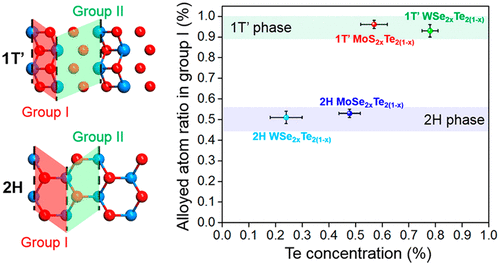Our official English website, www.x-mol.net, welcomes your feedback! (Note: you will need to create a separate account there.)
Anisotropic Ordering in 1T′ Molybdenum and Tungsten Ditelluride Layers Alloyed with Sulfur and Selenium
ACS Nano ( IF 17.1 ) Pub Date : 2018-01-09 00:00:00 , DOI: 10.1021/acsnano.7b08782 Junhao Lin 1 , Jiadong Zhou 2 , Sebastian Zuluaga 3 , Peng Yu 2 , Meng Gu 4 , Zheng Liu 2 , Sokrates T. Pantelides 3, 5 , Kazu Suenaga 1, 6
ACS Nano ( IF 17.1 ) Pub Date : 2018-01-09 00:00:00 , DOI: 10.1021/acsnano.7b08782 Junhao Lin 1 , Jiadong Zhou 2 , Sebastian Zuluaga 3 , Peng Yu 2 , Meng Gu 4 , Zheng Liu 2 , Sokrates T. Pantelides 3, 5 , Kazu Suenaga 1, 6
Affiliation

|
Alloying is an effective way to engineer the band-gap structure of two-dimensional transition-metal dichalcogenide materials. Molybdenum and tungsten ditelluride alloyed with sulfur or selenium layers (MX2xTe2(1–x), M = Mo, W and X = S, Se) have a large band-gap tunability from metallic to semiconducting due to the 2H-to-1T′ phase transition as controlled by the alloy concentrations, whereas the alloy atom distribution in these two phases remains elusive. Here, combining atomic resolution Z-contrast scanning transmission electron microscopy imaging and density functional theory (DFT), we discovered that anisotropic ordering occurs in the 1T′ phase, in sharp contrast to the isotropic alloy behavior in the 2H phase under similar alloy concentration. The anisotropic ordering is presumably due to the anisotropic bonding in the 1T′ phase, as further elaborated by DFT calculations. Our results reveal the atomic anisotropic alloyed behavior in 1T′ phase layered alloys regardless of their alloy concentration, shining light on fine-tuning their physical properties via engineering the alloyed atomic structure.
中文翻译:

硫和硒合金化的1T'钼和二碲化钨层中的各向异性有序化
合金化是设计二维过渡金属二卤化碳材料的带隙结构的有效方法。钼和钨与碲或硒层(MX 2 x Te 2(1- x),M = Mo,W和X = S,Se)形成合金,由于2H-由合金浓度控制的-1T'相转变,而在这两个相中的合金原子分布仍然难以捉摸。在这里,结合原子分辨率Z对比扫描透射电子显微镜成像和密度泛函理论(DFT),我们发现在相似合金浓度下2T相中的各向同性合金行为与之形成鲜明对比,在1T'相中发生了各向异性有序化。各向异性排序可能是由于1T'相中的各向异性键合,如DFT计算所进一步阐述的。我们的研究结果揭示了1T'相层状合金中的原子各向异性合金行为,而不管它们的合金浓度如何,通过对合金原子结构进行工程化处理,微调了它们的物理性质,从而发光了。
更新日期:2018-01-09
中文翻译:

硫和硒合金化的1T'钼和二碲化钨层中的各向异性有序化
合金化是设计二维过渡金属二卤化碳材料的带隙结构的有效方法。钼和钨与碲或硒层(MX 2 x Te 2(1- x),M = Mo,W和X = S,Se)形成合金,由于2H-由合金浓度控制的-1T'相转变,而在这两个相中的合金原子分布仍然难以捉摸。在这里,结合原子分辨率Z对比扫描透射电子显微镜成像和密度泛函理论(DFT),我们发现在相似合金浓度下2T相中的各向同性合金行为与之形成鲜明对比,在1T'相中发生了各向异性有序化。各向异性排序可能是由于1T'相中的各向异性键合,如DFT计算所进一步阐述的。我们的研究结果揭示了1T'相层状合金中的原子各向异性合金行为,而不管它们的合金浓度如何,通过对合金原子结构进行工程化处理,微调了它们的物理性质,从而发光了。


























 京公网安备 11010802027423号
京公网安备 11010802027423号